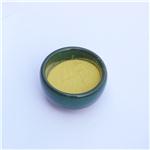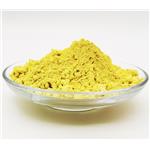A Review on the Structural Properties, Toxicological Analysis, and Ultrasonic-Assisted Applications of Pigment Yellow 83
Introduction
Pigment Yellow 83 is mainly used as colourants in inks, cosmetics and industrial paint and varnished. Pigment Yellow 83 owes its particular importance to its strong, bright reddish-yellow colour and its superior lightfastness and solvent resistance compared with other Diarylide Yellows, and consequently it is suited to a wider range of application. In the cosmetic industry, Pigment Yellow can be used in products such as bath salts, face makeup, mascara, hair dye, nail polish and showering products. It can also be used as colourants in industrial and decorative paints, varnishes, painting inks and plastic (polymers), in the reproduction of recorded sound, image and data storage media. The use of several of the yellow pigments as tattoo inks has been reported, but these colourants are not manufactured or recommended for this application. [1]

Toxic Effects and Mode of Action
By studied, Pigment Yellow 83 was found to be insoluble in the body and in phagolysosomal solution in vitro, which simulates the lung environment. The carcinogenic 3,3’-dichlorobenzidine was not released. Systemic toxicity was not observed in oral studies in rats and mice with exposure periods of up to 2 years. Therefore, these 3 pigments are insoluble and not bioavailable. If inhaled, insoluble particles can accumulate in the lung. In two 5-day inhalation studies of Pigment Yellow 83 in rats, local effects in the lungs were observed, which were similar to those observed after exposure to granular biopersistent dusts. Long-term exposure to pigment concentrations which exceed the lung clearance capacity is assumed to result in particle-induce carcinogenic effects in the lung. [1]
The Crystal and Molecular Structure
The Pigment Yellow 83 crystallises in the monoclinic system, space group P21/C, with two molecules in the unit cell. The molecules exist in the bisketohydrazone tautomeric form and have crystallographic Ci symmetry. The intramolecular hydrogen bonding normally associated with this structure arrangement is observed, but there is no intermolecular hydrogen bonding. The crystal structure differs from those of previously reported Diarylide Yellow pigment (Y12, Y13, Y14 and Y63) in that the molecules are more nearly planar and the packing arrangement involves simple inclined stacks. The difference in crystal packing for Y83 is consistent with its inability to form solid solutions with the other pigments. [2]
Ultrasonic Assisted Eco-friendly Printing
In textile industry the ecofriendly printing process through modern tool such as ultrasonic radiation has a promising effect in enhancing their color characteristics as well as minimizing the pollution loads. For the present study, the cotton fabric and mixed paste of Pigment Yellow 83 and Black 7 were irradiated by ultrasonic (US) treatment for 10-30 min at 60℃. Printing was performed using non-irradiated and irradiated mixed pigment past onto irradiated and non-irradiated fabrics. The optimum value for US time was 10 min using irradiated Paste (RP) of 2, 4 and 10% pigments mixture onto non-irradiated fabric (NRC). [3]
Improvement of Color Electrophoretic Paint
The ultrafine paste used in electrophoretic paint was prepared via ultrasonic method with Pigment Yellow 83, octadecyl dimethyl benzyl ammonium chloride, and deionized water. The average particle size of the ultrafine paste was only 196nm and zata potential was 30 mV with ultrasound for 30 min and 2wt.% cationic dispersant. The conductivity of the paint was improved as the cationic dispersant increased. Centrifugal stability of the paint with ultrafine paste reached the maximum at 2wt.% cationic dispersant. Compared with the performances of cathodic electrophoretic paint with the ultrafine yellow paste, the anodic film was smooth, uniform, and neat with 0.5 wt.% cationic dispersant in the ultrafine yellow paste. Deposited amount of the anodic film was 27g/m2, which was higher than the cathodic film. The curing property, adhesion, and chemical resistance of the cathodic film were better than the anodic film. [4]
References:
[1] Hartwig, A., Arand, M., & MAK Commission. (2024). Pigment Yellow 12, Pigment Yellow 13, Pigment Yellow 83. The MAK Collection for Occupational Health and Safety, 9(1), Doc011.
[2] Barrow, M. J., Christie, R. M., & Badcock, T. D. (2003). The crystal and molecular structure of CI Pigment Yellow 83, a superior performance Diarylide Yellow pigment. Dyes and pigments, 57(2), 99-106.
[3] Gulzar, T., Kiran, S., Adeel, S., Aftab, Z., Frooq, T., Jannat, M., ... & Azhar, S. (2017). ULTRASONIC ASSISTED ECO-FRIENDLY PRINTING OF COTTON FABRIC USING MIXTURE OF PIGMENT YELLOW 83 WITH BLACK 7. Oxidation Communications, 40(2).
[4] Mao, H., Wang, K., Wang, C., & Wu, M. (2013). An improvement of color electrophoretic paint via ultrafine modified pigment paste. Journal of Adhesion Science and Technology, 28(2), 186–200. https://doi.org/10.1080/01694243.2013.833403
You may like
See also
Lastest Price from Pigment Yellow 83 manufacturers

US $0.00/KG2025-04-15
- CAS:
- 5567-15-7
- Min. Order:
- 1KG
- Purity:
- 99%
- Supply Ability:
- 500000kg

US $80.00-10.00/KG2025-03-07
- CAS:
- 5567-15-7
- Min. Order:
- 1KG
- Purity:
- 0.99
- Supply Ability:
- 20 tons
